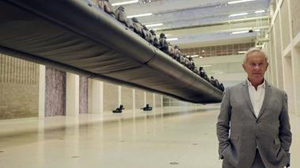 What Is Art Good For? (2018)
What Is Art Good For? (2018)
What can art do when civilization is lost, or in response to a horror like the Holocaust? Is art just a buzz or fashion, a realm of the rich, or is it somehow necessary to being fully human? This one-hour film narrated by the art historian Simon Schama of Columbia University argues passionately for the latter position, and does so with a historical romp that begins with the abstractions of modernism and ends in Israel with Michal Rovner. The film begins with an Austrian art teacher named Friedl Dicker-Brandeis who in December 1942 arrived at the Terezin ghetto, and while there gave art classes to the children. After the war, two secret suitcases of hers were found with 4,500 pieces of art by those children, which are now housed in the Pinkas Synagogue Art Museum in Prague. On Naoshima Island, Japan, the Chichu Art Museum was designed as a place of aesthetic power and spiritual purity beyond the consumerist culture, violence and ugliness of modern life. Contemporary art returned to representations of nature, person, story, and history, seen in the images of bombed out cities of Anselm Kiefer that were a sort of exorcism of German history and a protest against forgetting. Further cameos feature the African American Kara Walker, the Ghanian textile artist El Anatsui of Nigeria, whose works exude joy and beauty, and the Chinese Cai Guo-Qiang's use of gunpowder to depict the "terrible beauty" of creation and destruction. For Ai Weiwei, the signature issue of our age that captures his artistic imagination is the displacement of 65 million people worldwide. For 50,000 years, observes Schama, in every imaginable material and style, artists have re-imagined the world in unanticipated ways, giving us something that we can't find anywhere else, something that is both enduring and profound. I watched this film from the PBS website.


